فهرست مولکولهای فضای بیرونی
در اینجا فهرستی از مولکولهایی که در فضای خارجی زمین شامل محیطهای میان ستارهای و مجاور ستارهای،[lower-alpha 1] شناسایی شدهاند، بر مبنای تعداد اتمهای تشکیل دهنده، طبقهبندی شدهاند. علاوه بر فرمول شیمیایی، هر یک از این ترکیبات شناسایی شده، شکلهای یونیزه شده آنها نیز آورده شدهاست.
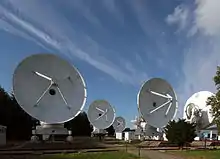

زمینه
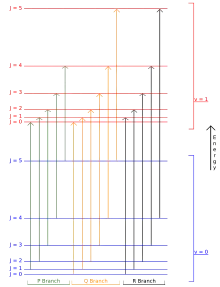
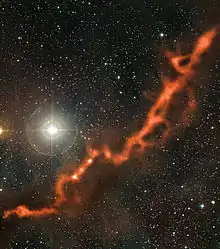
مولکولهای اشاره شده در این فهرست از طریق طیف سنجی نجومی شناسایی شدند. ویژگیهای مشخصه طیفی آنها برمبنای این واقعیت است که مولکولها در زمان انتقال بین دو سطح انرژی مولکولی، یک فوتون نور را جذب یا منتشر میکنند. انرژی (و بنابراین طول موج) این فوتون با اختلاف انرژی بین دو سطوح انرژی مورد نظر، مطابقت دارد. انتقالات الکترونی مولکولی هنگامی اتفاق میافتد که یکی از الکترونهای مولکول، بین اوربیتالهای مولکولی جابهجا شود. این انتقال موجب ایجاد خط طیفی در بخشهای مربوط به طول موجهای نواحی فرابنفش، مرئی یا فروسرخ نزدیک[توضیح 1]، در طیف الکترومغناطیسی میشود. روش دیگر، یک انتقال ارتعاشی، موجب انتقال یک کوانتوم انرژی به (یا از) ارتعاشات پیوندهای مولکولی میشود. این انتقال انرژی موجب شکلگیری اثری منحصربهفرد برای همان مولکول در بخش فروسرخ میانه یا دور در گستره امواج الکترومغناطیس میشود. مولکولهای فاز گازی نیز دارای سطوح چرخشی کوانتیزه هستند که منجر به انجام انتقالاتی در نواحی طول موج مربوط به امواج مایکروویو یا رادیویی میشوند.[1]
گاهی اوقات یک انتقال میتواند موجب انجام تغییرات انرژی بیش از یک نوع سطح انرژی را شامل شود. بهعنوان مثال، طیفسنجی چرخشی-ارتعاشی هردو سطح انرژی چرخشی و ارتعاشی مولکول را تغییر میدهد. گاهی اوقات انتقالاتی که هر سه سطح انرژی (الکترونی، چرخشی و ارتعاشی) را تحت تاثیر دهد، نیز رخ میدهد. بهعنوان مثال، نوار فیلیپس[lower-alpha 3] C۲ (کربن دواتمی)، که در آن یک انتقال الکترونی باعث ایجاد یک خط در ناحیه فروسرخ نزدیک میشود، خود به چندین نوار ارتعاشی ظریفتر تقسیم میشود و نوارهای مربوط به انتقالات ارتعاشی نیز خود بهصورت نوارهای ظریفتری که مربوط به تغییر سطوح انرژی چرخشی مولکول هستند، تقسیم میشوند.[2]
طیف یک مولکول خاص توسط قوانین انتخاب شیمی کوانتومی و تقارن مولکولی تعیین میشود. برخی از مولکولها دارای طیفهای سادهای هستند که به آسانی قابل شناسایی هستند، درحالی که برخی دیگر (که حتی بعضی از آنها مولکولهای کوچک هستند) دارای طیفهای بسیار پیچیدهای هستند که تشخیص آنها بسیار دشوار است.[3] برهمکنش میان هستههای اتمی و الکترونها، گاهی موجب ایجاد ساختارهای طیفی ظریفی میشود. همچنین اگر مولکول دارای اتمهای ایزوتوپی متعددی باشد (مولکولهایی که دارای ایزوتوپهای مختلفی از اتمها هستند)، بهعلت پدیده جابهجایی ایزوتوپی[lower-alpha 4]، طیف بهدست آمده از این مولکولها پیچیدهتر میشود.
کشف یک مولکول در محیطی در فضای بینستارهای یا مجاور ستارهای، در ابتدا نیاز به شناسایی یک جسم نجومی مناسب دارد. در مرحله بعد، باید جسم مورد نظر را با یک تلسکوپ مجهز به یک طیفنگار[lower-alpha 5] دارای توانایی کار در طول موج مورد نظر، وضوح طیفی و حساسیت مناسب، رصد نمود. اولین مولکول کشف شده در محیط میان ستارهای، رادیکال متیلیدین (•CH) در سال ۱۹۳۷بود . این ترکیب دارای یک انتقال الکترونی قوی در ۴۳۰۰ آنگستروم در ناحیه مرئی است.[4] پیشرفت در ابزارآلات نجومی، موجب افزایش تعداد مولکولهای کشف شده شد. از دهه ۱۹۵۰ میلادی به بعد، اخترشناسی رادیویی کمکم به روش اصلی کشف مولکولهای جدید در فضای خارجی تبدیل شد. از دهه ۱۹۹۰ میلادی، روش اخترشناسی زیرمیلیمتری[lower-alpha 6][توضیح 2] که به بررسی میلیمتری و بسیار ظریف طیفهای بهدست آمده از مولکولها مینماید، به عنوان روشی مهم در این زمینه تبدیل شد.[3]
بررسی مجموعه مولکولهای شناسایی شده، نشان میدهد که تاکنون، بیشتر مولکولهایی شناسایی شدهاند که کشف آنها آسانتر بودهاست. این موضوع به این علت است که بیشترین حساسیت روش اخترشناسی رادیویی متوجه مولکولهای خطی کوچک دارای دوقطبی الکتریکی مولکولی بالا است.[3] فراوانترین مولکول موجود در جهان، مولکول هیدروژن (H۲) است که بهطور کامل برای تلسکوپهای رادیویی نامرئی است، زیرا این مولکول فاقد دوقطبی الکتریکی است.[3] انتقالات الکترونی مولکول هیدروژن، نیازمند انرژی بسیار بالایی هستند که تشخیص آن برای تلسکوپهای مرئی ممکن نیست، بنابراین شناسایی مولکول هیدروژن نیازمند مشاهدات با کمک طول موج فرابنفش، با استفاده از یک موشک ژرفاسنج است.[5] نوارهای ارتعاشی غالباً مشخصهای اختصاصی برای هر مولکول ایجاد نمیکنند و معمولاً بهعنوان مشخصهای برای شناسایی یک طبقه از مولکولهای عمومی به شمار میآیند. بهعنوان مثال، هیدروکربنهای آروماتیک چندحلقهای (موسوم به PAHs) بهدلیل داشتن نوارهای ارتعاشی که مشخصه این خانواده از ترکیبات است، بهصورت وسیعی در طیفهای فروسرخ میانه[lower-alpha 7] مشاهده میشوند. با اینحال اگرچه با مشاهده این نوارها میتوان پیبرد که طیف ارتعاشی مورد نظر، متعلق به خانواده هیدروکربنهای آروماتیک چندحلقهای است، اما صرفاً با بررسی این نوارها (و بدون استفاده از سایر انتقالات)، نمیتوان بهطور دقیق مشخص کرد که طیف مورد نظر، دقیقاً متعلق به کدام مولکول هیدروکربن آروماتیک است.[6]
یکی از غنیترین محلها برای شناسایی مولکولهای بین ستارهای، ساگیتاریوس ب۲ است، یک ابر مولکولی غول پیکر که در نزدیکی مرکز کهکشان راه شیری واقع شدهاست. حدود نیمی از مولکولهای موجود در فهرستهای زیر، ابتدا در این ابر کشف شدهاند و بسیاری دیگر نیز که ابتدا در جای دیگری کشف شدهاند، بعداً در ساگیتاریوس ب۲ نیز یافت شدند.[7] یکی از منابع مملو از مولکولها، ناحیهای در مجاورت ستارهای بهنام آیآرسی ۱۰۲۱۶+ در صورت فلکی شیر است، ناحیهای نزدیک یک ستاره کربنی که بیش از ۵۰ مولکول در آن شناسایی شدهاست.[7] هیچ مرز مشخصی بین محیط میانستارهای و محیط مجاور ستارهای وجود ندارد، بنابراین در جدولهای زیر، مولکولها، بدون اشاره به محیط کشف شده، آورده شدهاند.
اخترشیمی، دانشی است که به توضیح چگونگی تشکیل این مولکولها و علت ظاهر طیفی آنها میپردازد. چگالی بسیار پایین محیط میانستارهای محیط مناسبی برای تشکیل مولکولها نیست، چون برهمکنشهای متداول فاز گازی میان گونههای خنثی (اتمها یا مولکولها) بهصورت موثری رخ نمیدهد. بسیاری از مناطق، دارای درجه حرارت بسیار پایینی هستند (بهطور معمول دمای داخل یک ابر مولکولی ۱۰ درجه کلوین است)، که این موضوع خود موجب کاهش بیشتر میزان نرخ انجام واکنش یا اثر مخرب فتوشیمیایی پرتو فرابنفش، بر مولکولها میشود.[8] توضیح فراوانی مولکولهای بین ستارهای مشاهده شده، نیازمند محاسبه تعادل میان سرعت تشکیل و تخریب مولکولها با استفاده از شیمی یونهای موجود در فاز گازی، شیمی سطح گرد و غبارهای کیهانی، انتقال تابشی مانند خاموشی بینستارهای و بررسی مجموعهای از واکنشهای پیچیده است.[9]
 یک اخترشیمیدان مشغول کار با یک دستگاه تبخیرکننده دوار
یک اخترشیمیدان مشغول کار با یک دستگاه تبخیرکننده دوار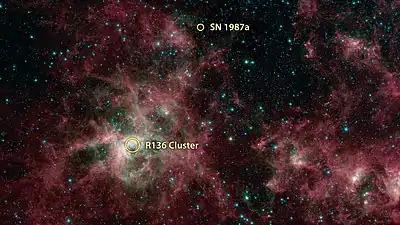
 تلسکوپ سوئدی زیرمیلیمتری ایاساو (ESO)
تلسکوپ سوئدی زیرمیلیمتری ایاساو (ESO)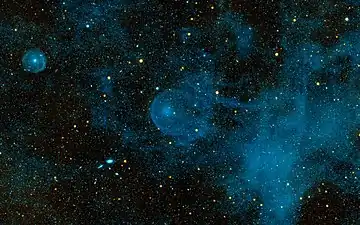 ستاره آیآرسی +۱۰۲۱۶ در صورت فلکی شیر
ستاره آیآرسی +۱۰۲۱۶ در صورت فلکی شیر
مولکولها
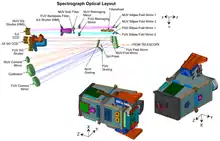
در جدولهایی که ادامه قرار گرفتهاند، فهرست مولکولهایی آورده شدهاست که در محیطهای میانستارهای یا نزدیک ستارهای، شناسایی شدهاند که براساس تعداد اتمها دستهبندی شدهاند. مولکولهای خنثی و یونهای مولکولی آنها، در ستونهای مجزا فهرست شدهاند. اگر هیچ گونه دادهای برای فرمول مولکول خنثی برای یک ترکیب قرار داده نشده بود، به این معنی است که تنها شکل یونیزه شده مولکول مورد نظر شناسایی شدهاست. نام مولکولها برمبنای نامهایی که در منابع علمی استفاده میشوند، اورده شدهاند و در صورتی که هیچ نامی برای آنها وجود نداشته باشد، قسمت مربوط خالی گذاشته شدهاست. جرمهای فهرست شده در جدولها، برمبنای یکای جرم اتمی آورده شدهاند و چنانچه گونههایی وجود داشته باشند که تفاوت آنها، تنها یک اتم دوتریوم (۲H) باشد، بهخاطر تفاوت جرم اندک بهوجود آمده، به هرکدام سطر جداگانهای در جدوا مورد نظر، اختصاص داده شدهاست. تعداد مجموع گونههای منحصر بهفرد، از جمله حالتهای یونیزه شده مجزا، در هر بخش نشان داده شدهاند. بیشتر مولکولهایی که تاکنون کشفه شدهاند، مولکولهای آلی هستند.[10] تنها مولکول معدنی شناسایی شده با پنج اتم یا بیشتر، مولکول سیلان (SiH۴) است. مولکولهای بزرگتر کشف شده، دارای حداقل یک اتم کربن هستند و فاقد پیوندهای پیوند نیتروژن-نیتروژن یا اکسیژن-اکسیژن هستند.[10]
دو اتمی

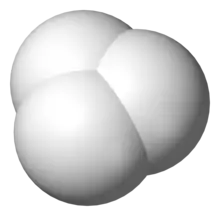
۳H، یکی از فراوانترین یونها در کیهان است. این گونه برای اولین بار در سال ۱۹۹۳ کشف شد.
سه اتمی
چهار اتمی
| مولکول | نام | جرم | یونها |
|---|---|---|---|
| CH۳ | رادیکال متیل[86] | ۱۵ | — |
| l-C۳H | پروپینیلیدین[12][87] | ۳۷ | +l-C۳H[88] |
| c-C۳H | سیکلوپروپینیلیدین[89] | ۳۷ | — |
| C۳N | سیانواتینیل[90] | ۵۰ | −C۳N[91] |
| C۳O | تریکربن مونوکسید[87] | ۵۲ | — |
| C۳S | تریکربن مونوسولفید[12][56] | ۶۸ | — |
| — | هیدرونیوم | ۱۹ | +H۳O[92] |
| C۲H۲ | استیلن[93] | ۲۶ | — |
| H۲CN | متیلن آزانیل[94] | ۲۸ | +H۲CN[23] |
| H۲CO | فرمالدهید[95] | ۳۰ | — |
| H۲CS | تیوفرمالدهید[96] | ۴۶ | — |
| HCCN | —[97] | ۳۹ | — |
| HCCO | کتنیل[lower-alpha 10][98] | ۴۱ | — |
| — | هیدروژن سیانید پرتوندار شده | ۲۸ | +HCNH[72] |
| — | کربن دیاکسید پرتوندار شده | ۴۵ | +HOCO[99] |
| HCNO | فولمینیک اسید[100] | ۴۳ | — |
| HOCN | ایزوسیانیک اسید[101] | ۴۳ | — |
| CNCN | ایزوسیانوژن[lower-alpha 11][102] | ۵۲ | — |
| HOOH | هیدروژن پراکسید[103] | ۳۴ | — |
| HNCO | ایزوسیانیک اسید[82] | ۴۳ | — |
| HNCS | تیوسیانیک اسید[104] | ۵۹ | — |
| NH۳ | آمونیاک[12][105] | ۱۷ | — |
| HSCN | تیوسیانیک اسید[106] | ۵۹ | — |
| SiC۳ | سیلیسیوم تریکاربید[lower-alpha 12][12] | ۶۴ | — |
| HMgNC | هیدرومنیزیم ایزوسیانید[107] | ۵۱٫۳ | — |
| HNO۲ | نیترو اسید[108] | ۴۷ | — |
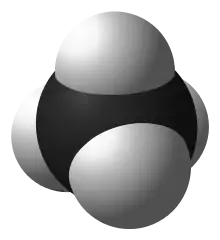
پنج اتمی
| مولکول | نام | جرم | یونها |
|---|---|---|---|
| - | یون آمونیوم [110] [111] | ۱۸ | +NH۴ |
| CH۴ | متان[112] | ۱۶ | — |
| CH3O | رادیکال متوکسی[113] | ۳۱ | — |
| c-C۳H۲ | سیکلوپروپنیلیدن[24][114][115] | ۳۸ | — |
| l-H۲C۳ | پروپادیانیلیدن[lower-alpha 13][115] | ۳۸ | — |
| H۲CCN | سیانومتیل[116] | ۴۰ | — |
| H۲C۲O | اتنون[82] | ۴۲ | — |
| H۲CNH | متیلنایمین[117] | ۲۹ | — |
| HNCNH | کربودیایمید[118] | ۴۲ | — |
| — | فرمالدهید پروتوندار شده[119] | ۳۱ | +H۲COH |
| C۴ | بوتادیاینیل[12] | ۴۹ | -C۴H[120] |
| HC۳N | سیانواستیلن[12][24][72][121][122] | ۵۱ | — |
| HCC-NC | ایزوسیانواستیلن[123] | ۵۱ | — |
| HCOOH | اسید فرمیک[124][121] | ۴۶ | — |
| NH۲CN | سیانامید[125] | ۴۲ | — |
| — | سیانوژن پروتوندار شده[126] | ۵۳ | +NCCNH |
| HC(O)CN | سیانوفرمالدهید[127] | ۵۵ | — |
| C۵ | C۵ خطی[128] | ۶۰ | — |
| SiC۴ | خوشه سیلیسیم کاربید[49] | ۹۲ | — |
| SiH۴ | سیلان[129] | ۳۲ | — |
شش اتمی
| فرمول | نام | جرم | یونها |
|---|---|---|---|
| c-H۲C۳O | سیکلوپروپنون[130] | ۵۴ | — |
| E-HNCHCN | E-سیانومتانیمین[131] | ۵۴ | — |
| C۲H۴ | اتیلن[132] | ۲۸ | — |
| CH۳CN | استونیتریل [133] | ۴۰ | — |
| CH۳NC | متیل ایزوسیانید[134] | ۴۰ | — |
| CH۳OH | متانول [135] | ۳۲ | — |
| CH۳SH | متانتیول[136] | ۴۸ | — |
| H۲C۴ | دیاستیلن[12][137] | ۵۰ | — |
| — | سیانواستیلن پروتوندار شده[72] | ۵۲ | +HC۳NH |
| HCONH۲ | فرمامید[138] | ۴۴ | — |
| C۵H | پنتینیلیدین[12][56] | ۶۱ | — |
| C۵N | رادیکال سیانوبوتادیاینیل[lower-alpha 14][139] | ۷۴ | — |
| HC ۲ CHO | پروپینال[140] | ۵۴ | — |
| HC۴N | —[12] | ۶۳ | — |
| CH۲CNH | کتنایمین[114] | ۴۰ | — |
| C۵S | —[141] | ۹۲ | — |
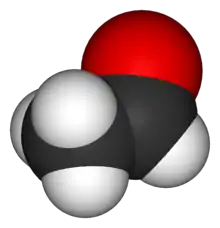
هفت اتمی
| مولکول | نام | جرم | یونها |
|---|---|---|---|
| c-C۲H۴O | اکسید اتیلن[142] | ۴۴ | — |
| CH۳C۲H | متیل استیلن[24] | ۴۰ | — |
| H۳CNH۲ | متیل آمین[143] | ۳۱ | — |
| CH۲CHCN | آکریلونیتریل[82][134] | ۵۳ | — |
| H۲CHCOH | الکل وینیل[144] | ۴۴ | — |
| C۶ | رادیکال هگزاتریئینل [12][56] | ۷۳ | -C۶H[115][145] |
| HC۴CN | سیانودیاستیلن[82][122][134] | ۷۵ | — |
| HC۵O | —[146] | ۷۷ | — |
| CH۳CHO | استالدهید[12][142] | ۴۴ | — |
| CH۳NCO | ایزوسیانات متیل[147] | ۵۷ | — |
| HOCH۲CN | گلیکولونیتریل[148] | ۵۷ | — |
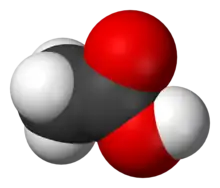
هشت اتمی
| مولکول | نام | جرم |
|---|---|---|
| H۳CC۲CN | متیل سیانواستیلن[149] | ۶۵ |
| H۲COCHCHO | گلیكوآلدئید[150] | ۶۰ |
| HCOOCH۳ | متیل فرمات[82][121][150] | ۶۰ |
| CH۳COOH | اسید استیک[151] | ۶۰ |
| C۲H۶ | هگزاپنتاانیلیدین[12][137] | ۷۴ |
| CH۲CHCHO | پروپنال[114] | ۵۶ |
| CH۲CCHCN | سیانوآلن[114][149] | ۶۵ |
| CH۳CHNH | اتانیمین[152] | ۴۳ |
| C۷H | رادیکال هپاتریانیل[153] | ۸۵ |
| NH۲CH۲CN | آمینواستونیتریل[154] | ۵۶ |
| CO(NH۲)۲ | اوره[155] | ۶۰ |
نه اتمی
| فرمول | نام | جرم | یونها |
|---|---|---|---|
| CH۳C۴H | متیل دیاستیلن[156] | ۶۴ | — |
| CH۲OCH۲ | دیمتیل اتر[157] | ۴۶ | — |
| CH۳CH۲CN | پروپاننیتریل[12][82][134] | ۵۵ | — |
| CH۳CONH۲ | استامید[114][138] | ۵۹ | — |
| CH۳CH۲OH | اتانول[158] | ۴۶ | — |
| C۸H | رادیکال اوکتاتترائینیل[159] | ۹۷ | -C۸H [160][161] |
| HC۷N | سیانوهگزاتریان یا سیانوتریاستیلن[12][105][162][163] | ۹۹ | — |
| CH۳CHCH۲ | پروپن[164] | ۴۲ | — |
| CH۳CH۲SH | اتیل مرکاپتان[165] | ۶۲ | — |
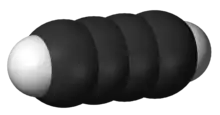
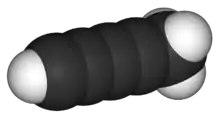

ده اتمی یا بیشتر
| تعداد اتمها | فرمول | نام | جرم | یونها |
|---|---|---|---|---|
| ۱۰ | CO(CH۳)۲ | استون[82][166] | ۵۸ | — |
| ۱۰ | ۲(CH۲OH) | اتیلن گلیکول[167][168] | ۶۲ | — |
| ۱۰ | CH۳CH۲CHO | پروپانال[114] | ۵۸ | — |
| ۱۰ | CH۳OCH۲OH | متوکسیمتانول[169] | ۶۲ | — |
| ۱۰ | CH۳C۵N | متیل سیانودیاستیلن[114] | ۸۹ | — |
| ۱۰ | CH۳CHCH۲O | پروپیلن اکسید[170] | ۵۸ | — |
| ۱۱ | HC۸CN | سیانوتتراستیلن[12][162] | ۱۲۳ | — |
| ۱۱ | C۲H۵OCHO | اتیل فرمات[171] | ۷۴ | — |
| ۱۱ | CH۳COOCH۳ | متیل استات[172] | ۷۴ | — |
| ۱۱ | CH۳C۶H | متیل تریاستیلن[114][156] | ۸۸ | — |
| ۱۲ | C۶H۶ | بنزن[137] | ۷۸ | — |
| ۱۲ | C۳H۷CN | بوتیرونیتریل[171] | ۶۹ | — |
| ۱۲ | CHCN(CH۳)۲ | ایزوپروپیل سیانید[173] [174] | ۶۹ | — |
| ۱۳ | C۶H۵CN | بنزونیتریل[175] | ۱۰۴ | — |
| ۱۳ | HC۱۰CN | سیانوپنتااستیلن[162] | ۱۴۷ | — |
| ۶۰ | C۶۰ | فولرن C۶۰ [176][177][178] | ۷۲۰ | +C۶۰ [176][177][178] |
| ۷۰ | C۷۰ | فولرن C۷۰[179] | ۸۴۰ | — |
مولکولهای دوتریومدار
همه این مولکولها دارای یک یا چند اتم دوتریوم (ایزوتوپ سنگین هیدروژن) هستند.
| تعداد اتمها | مولکول | نام | جرم |
|---|---|---|---|
| ۲ | HD | هیدروژن دوترید[180] | ۳ |
| ۳ | +H۲D و +HD۲ | کاتیون تریهیدروژن[181][180] | ۴ و ۵ |
| ۳ | HDO و D۲O | آب سنگین[182][183] | ۱۹ و ۲۰ |
| ۳ | DCN | سیانید هیدروژن[184] | ۲۸ |
| ۳ | DCO | رادیکال فرمیل[184] | ۳۰ |
| ۳ | DNC | ایزوسیانید هیدروژن[184] | ۲۸ |
| ۳ | +N۲D | —[184] | ۳۰ |
| ۴ | NH۲D ،NHD۲ و ND۳ | آمونیاک[180][185][186] | ۱۸-۲۰ |
| ۴ | HDCO و D۲CO | فرمالدئید[180][187] | ۳۱ و ۳۲ |
| ۴ | DNCO | ایزوسیانیک اسید [188] | ۴۴ |
| ۵ | +NH۳D | یون آمونیوم[189][190] | ۱۹ |
| ۶ | NH۲CDO و NHDCHO | فرمامید[188] | ۴۶ |
| ۷ | CH۲DCCH و CH۳CCD | متیل استیلن[191][192] | ۴۱ |
تأیید نشده
گزارشهای در مورد تایید وجود مولکولهای زیر در فضا خارجی در منابع علمی وجود دارد، اما این مولکولها بهصورت نتایجی توصیفی توسط پژوهشگران مربوط، ارائه شدهاند یا اینکه توسط پژوهشگران دیگر به چالش کشیده شدهاند. در نتیجه این مولکولها هنوز منتظر تأیید مستقل هستند.
| تعداد اتمها | مولکول | نام |
|---|---|---|
| ۲ | SiH | سیلیلیدین[69] |
| ۴ | PH۳ | فسفین[193] |
| ۴ | MgCCH | منیزیم مونواستیلید[141] |
| ۴ | NCCP | سیانوفسفااتین[141] |
| ۵ | +H۲NCO | —[194] |
| ۴ | SiH۳CN | سیلیل سیانید[141] |
| ۱۰ | H۲NCH۲COOH | گلیسین[195][196] |
| ۱۲ | CO(CH۲OH)۲ | دیهیدروکسی استون[197] |
| ۱۲ | C۲H۵OCH۳ | اتیل متیل اتر[198] |
| ۱۸ | +C۱۰H۸O | کاتیون نفتالین[199] |
| ۲۴ | C۲۴ | گرافن[200] |
| ۲۴ | C۱۴H۱۰ | آنتراسن [201][202] |
| ۲۶ | C۱۶H۱۰ | پیرن[201] |
توضیحات
- ناحیهای در قسمت فروسرخ در امواج الکترومغناطیس که دارای گستره طول موجی بین ۰٫۷۵ تا ۱٫۴ میکرومتر است.
- روش اخترشناسی زیرمیلیمتری، روشی است که به بررسی بسیار ظریف طیفهای نشری بهدست آمده از مولکولهای موجود در فضای خارجی مینماید.
- روی زمین، ایزوتوپ غالب اتم آرگون، آرگون-۴۰ است (۴۰Ar). بنابراین گونه +ArH، دارای جرم ۴۱ (واحد اتمی) است. با اینحال، +ArH شناسایی شده در فضای خارجی دارای آرگون-۳۶ بوده است که موجب میشود جرم اتمی مجموع گونه مورد نظر، ۳۷ باشد.
واژهنامه
- Circumstellar envelope
- Taurus
- Phillips band
- Isotopic shift
- Spectrograph
- Submillimetre astronomy
- mid-Infrared
- Fluoromethylidynium
- Cyanomethylidyne
- Ketenyl
- Isocyanogen
- Silicon tricarbide
- Propadienylidene
- Cyanobutadiynyl radical
جستارهای وابسته
منابع
- Shu, Frank H. (1982), The Physical Universe: An Introduction to Astronomy, University Science Books, ISBN 978-0-935702-05-7, archived from the original on 17 December 2019, retrieved 20 June 2020
- Chaffee, Frederick H.; Lutz, Barry L.; Black, John H.; Vanden Bout, Paul A.; Snell, Ronald L. (1980). "Rotational fine-structure lines of interstellar C2 toward Zeta Persei". The Astrophysical Journal. 236: 474. Bibcode:1980ApJ...236..474C. doi:10.1086/157764.
- McGuire, Brett A. (2018). "2018 Census of Interstellar, Circumstellar, Extragalactic, Protoplanetary Disk, and Exoplanetary Molecules". The Astrophysical Journal Supplement Series. 239 (2): 17. arXiv:1809.09132. Bibcode:2018ApJS..239...17M. doi:10.3847/1538-4365/aae5d2.
- Woon, D. E. (May 2005), Methylidyne radical, The Astrochemist, archived from the original on 19 March 2007, retrieved 2007-02-13
- Carruthers, George R. (1970), "Rocket Observation of Interstellar Molecular Hydrogen", Astrophysical Journal, 161: L81–L85, Bibcode:1970ApJ...161L..81C, doi:10.1086/180575
- Cummins, S. E.; Linke, R. A.; Thaddeus, P. (1986), "A survey of the millimeter-wave spectrum of Sagittarius B2", Astrophysical Journal Supplement Series, 60: 819–878, Bibcode:1986ApJS...60..819C, doi:10.1086/191102
- Kaler, James B. (2002), The hundred greatest stars, Copernicus Series, Springer, ISBN 978-0-387-95436-3, retrieved 2011-05-09
- Brown, Laurie M.; Pais, Abraham; Pippard, A. B. (1995), "The physics of the interstellar medium", Twentieth Century Physics (2nd ed.), CRC Press, p. 1765, ISBN 978-0-7503-0310-1
- Dalgarno, A. (2006), "Interstellar Chemistry Special Feature: The galactic cosmic ray ionization rate", Proceedings of the National Academy of Sciences, 103 (33): 12269–12273, Bibcode:2006PNAS..10312269D, doi:10.1073/pnas.0602117103, PMC 1567869, PMID 16894166
- Klemperer, William (2011), "Astronomical Chemistry", Annual Review of Physical Chemistry, 62: 173–184, Bibcode:2011ARPC...62..173K, doi:10.1146/annurev-physchem-032210-103332, PMID 21128763
- The Structure of Molecular Cloud Cores, Centre for Astrophysics and Planetary Science, University of Kent, archived from the original on 29 June 2012, retrieved 2007-02-16
- Ziurys, Lucy M. (2006), "The chemistry in circumstellar envelopes of evolved stars: Following the origin of the elements to the origin of life", Proceedings of the National Academy of Sciences, 103 (33): 12274–12279, Bibcode:2006PNAS..10312274Z, doi:10.1073/pnas.0602277103, PMC 1567870, PMID 16894164
- Cernicharo, J.; Guelin, M. (1987), "Metals in IRC+10216 - Detection of NaCl, AlCl, and KCl, and tentative detection of AlF", Astronomy and Astrophysics, 183 (1): L10–L12, Bibcode:1987A&A...183L..10C
- Ziurys, L. M.; Apponi, A. J.; Phillips, T. G. (1994), "Exotic fluoride molecules in IRC +10216: Confirmation of AlF and searches for MgF and CaF", Astrophysical Journal, 433 (2): 729–732, Bibcode:1994ApJ...433..729Z, doi:10.1086/174682
- Tenenbaum, E. D.; Ziurys, L. M. (2009), "Millimeter Detection of AlO (X2Σ+): Metal Oxide Chemistry in the Envelope of VY Canis Majoris", Astrophysical Journal, 694 (1): L59–L63, Bibcode:2009ApJ...694L..59T, doi:10.1088/0004-637X/694/1/L59
- Barlow, M. J.; Swinyard, B. M.; Owen, P. J.; Cernicharo, J.; Gomez, H. L.; Ivison, R. J.; Lim, T. L.; Matsuura, M.; Miller, S.; Olofsson, G.; Polehampton, E. T. (2013), "Detection of a Noble Gas Molecular Ion, 36ArH+, in the Crab Nebula", ساینس, 342 (6164): 1343–1345, arXiv:1312.4843, Bibcode:2013Sci...342.1343B, doi:10.1126/science.1243582, PMID 24337290
- Quenqua, Douglas (13 December 2013). "Noble Molecules Found in Space". نیویورک تایمز. Archived from the original on 2 April 2019. Retrieved 13 December 2013.
- Souza, S. P; Lutz, B. L (1977). "Detection of C2 in the interstellar spectrum of Cygnus OB2 number 12 /VI Cygni number 12/". The Astrophysical Journal. 216: L49. Bibcode:1977ApJ...216L..49S. doi:10.1086/182507.
- Lambert, D. L.; Sheffer, Y.; Federman, S. R. (1995), "Hubble Space Telescope observations of C2 molecules in diffuse interstellar clouds", Astrophysical Journal, 438: 740–749, Bibcode:1995ApJ...438..740L, doi:10.1086/175119
- Neufeld, D. A.; et al. (2006), "Discovery of interstellar CF+", Astronomy and Astrophysics, 454 (2): L37–L40, arXiv:astro-ph/0603201, Bibcode:2006A&A...454L..37N, doi:10.1051/0004-6361:200600015
- Landau, Elizabeth (12 October 2016). "Building Blocks of Life's Building Blocks Come From Starlight". ناسا. Archived from the original on 13 اكتبر 2016. Retrieved 13 October 2016. Check date values in:
|archivedate=(help) - Adams, Walter S. (1941), "Some Results with the COUDÉ Spectrograph of the Mount Wilson Observatory", Astrophysical Journal, 93: 11–23, Bibcode:1941ApJ....93...11A, doi:10.1086/144237
- Smith, D. (1988), "Formation and Destruction of Molecular Ions in Interstellar Clouds", Philosophical Transactions of the Royal Society of London, 324 (1578): 257–273, Bibcode:1988RSPTA.324..257S, doi:10.1098/rsta.1988.0016
- Fuente, A.; et al. (2005), "Photon-dominated Chemistry in the Nucleus of M82: Widespread HOC+ Emission in the Inner 650 Parsec Disk", Astrophysical Journal, 619 (2): L155–L158, arXiv:astro-ph/0412361, Bibcode:2005ApJ...619L.155F, doi:10.1086/427990
- Guelin, M.; Cernicharo, J.; Paubert, G.; Turner, B. E. (1990), "Free CP in IRC + 10216", Astronomy and Astrophysics, 230: L9–L11, Bibcode:1990A&A...230L...9G
- Dopita, Michael A.; Sutherland, Ralph S. (2003), Astrophysics of the diffuse universe, Springer-Verlag, ISBN 978-3-540-43362-0
- Agúndez, M.; et al. (2010-07-30), "Astronomical identification of CN−, the smallest observed molecular anion", Astronomy & Astrophysics, 517: L2, arXiv:1007.0662, Bibcode:2010A&A...517L...2A, doi:10.1051/0004-6361/201015186, archived from the original on 6 April 2012, retrieved 2010-09-03
- Khan, Amina. "Did two planets around nearby star collide? Toxic gas holds hints". لس آنجلس تایمز. Archived from the original on 10 March 2014. Retrieved March 9, 2014.
- Dent, W.R.F.; Wyatt, M.C.;Roberge, A.; Augereau, J.-C.; Casassus, S.;Corder, S.; Greaves, J.S.; de Gregorio-Monsalvo, I; Hales, A.; Jackson, A.P.; Hughes, A. Meredith; Lagrange, A.-M; Matthews, B.; Wilner, D. (March 6, 2014). "Molecular Gas Clumps from the Destruction of Icy Bodies in the β Pictoris Debris Disk". ساینس. 343 (6178): 1490–1492. arXiv:1404.1380. Bibcode:2014Sci...343.1490D. doi:10.1126/science.1248726. PMID 24603151.
- Latter, W. B.; Walker, C. K.; Maloney, P. R. (1993), "Detection of the Carbon Monoxide Ion (CO+) in the Interstellar Medium and a Planetary Nebula", Astrophysical Journal Letters, 419: L97, Bibcode:1993ApJ...419L..97L, doi:10.1086/187146
- Furuya, R. S.; et al. (2003), "Interferometric observations of FeO towards Sagittarius B2", Astronomy and Astrophysics, 409 (2): L21–L24, Bibcode:2003A&A...409L..21F, doi:10.1051/0004-6361:20031304
- Fisher, Christine (17 April 2019). "NASA finally found evidence of the universe's earliest molecule - The elusive helium hydride was found 3,000 light-years away". انگجت. Archived from the original on 5 June 2019. Retrieved 17 April 2018.
- Güsten, Rolf; et al. (17 April 2019). "Astrophysical detection of the helium hydride ion HeH+". نیچر. 568 (7752): 357–359. arXiv:1904.09581. Bibcode:2019Natur.568..357G. doi:10.1038/s41586-019-1090-x. PMID 30996316.
- Blake, G. A.; Keene, J.; Phillips, T. G. (1985), "Chlorine in dense interstellar clouds - The abundance of HCl in OMC-1" (PDF), Astrophysical Journal, Part 1, 295: 501–506, Bibcode:1985ApJ...295..501B, doi:10.1086/163394, archived (PDF) from the original on 9 August 2017, retrieved 20 June 2020
- De Luca, M.; Gupta, H.; Neufeld, D.; Gerin, M.; Teyssier, D.; Drouin, B. J.; Pearson, J. C.; Lis, D. C.; et al. (2012), "Herschel/HIFI Discovery of HCl+ in the Interstellar Medium", The Astrophysical Journal Letters, 751 (2): L37, Bibcode:2012ApJ...751L..37D, doi:10.1088/2041-8205/751/2/L37
- Neufeld, David A.; et al. (1997), "Discovery of Interstellar Hydrogen Fluoride", Astrophysical Journal Letters, 488 (2): L141–L144, arXiv:astro-ph/9708013, Bibcode:1997ApJ...488L.141N, doi:10.1086/310942
- Wyrowski, F.; et al. (2009), "First interstellar detection of OH+", Astronomy & Astrophysics, 518: A26, arXiv:1004.2627, Bibcode:2010A&A...518A..26W, doi:10.1051/0004-6361/201014364
- Meyer, D. M.; Roth, K. C. (1991), "Discovery of interstellar NH", Astrophysical Journal Letters, 376: L49–L52, Bibcode:1991ApJ...376L..49M, doi:10.1086/186100
- Wagenblast, R.; et al. (January 1993), "On the origin of NH in diffuse interstellar clouds", Monthly Notices of the Royal Astronomical Society, 260 (2): 420–424, Bibcode:1993MNRAS.260..420W, doi:10.1093/mnras/260.2.420
- <Please add first missing authors to populate metadata.> (June 9, 2004), Astronomers Detect Molecular Nitrogen Outside Solar System, Space Daily, archived from the original on 10 December 2008, retrieved 2010-06-25
- Knauth, D. C; et al. (2004), "The interstellar N2 abundance towards HD 124314 from far-ultraviolet observations", Nature, 429 (6992): 636–638, Bibcode:2004Natur.429..636K, doi:10.1038/nature02614, PMID 15190346
- McGonagle, D.; et al. (1990), "Detection of nitric oxide in the dark cloud L134N", Astrophysical Journal, Part 1, 359 (1 Pt 1): 121–124, Bibcode:1990ApJ...359..121M, doi:10.1086/169040, PMID 11538685
- Staff writers (March 27, 2007), Elusive oxygen molecule finally discovered in interstellar space, Physorg.com, archived from the original on 4 July 2007, retrieved 2007-04-02
- Turner, B. E.; Bally, John (1987). "Detection of interstellar PN - the first identified phosphorus compound in the interstellar medium". The Astrophysical Journal. 321: L75. Bibcode:1987ApJ...321L..75T. doi:10.1086/185009.
- Ziurys, L. M. (1987), "Detection of interstellar PN - The first phosphorus-bearing species observed in molecular clouds", Astrophysical Journal Letters, 321 (1 Pt 2): L81–L85, Bibcode:1987ApJ...321L..81Z, doi:10.1086/185010, PMID 11542218
- Tenenbaum, E. D.; Woolf, N. J.; Ziurys, L. M. (2007), "Identification of phosphorus monoxide (X 2 Pi r) in VY Canis Majoris: Detection of the first PO bond in space", Astrophysical Journal Letters, 666 (1): L29–L32, Bibcode:2007ApJ...666L..29T, doi:10.1086/521361
- Yamamura, S. T.; Kawaguchi, K.; Ridgway, S. T. (2000), "Identification of SH v=1 Ro-vibrational Lines in R Andromedae", The Astrophysical Journal, 528 (1): L33–L36, arXiv:astro-ph/9911080, Bibcode:2000ApJ...528L..33Y, doi:10.1086/312420, PMID 10587489
- Menten, K. M.; et al. (2011), "Submillimeter Absorption from SH+, a New Widespread Interstellar Radical, 13CH+ and HCl", Astronomy & Astrophysics, 525: A77, arXiv:1009.2825, Bibcode:2011A&A...525A..77M, doi:10.1051/0004-6361/201014363, archived from the original on 2011-07-19, retrieved 2010-12-03.
- Pascoli, G.; Comeau, M. (1995), "Silicon Carbide in Circumstellar Environment", Astrophysics and Space Science, 226 (1): 149–163, Bibcode:1995Ap&SS.226..149P, doi:10.1007/BF00626907
- Kamiński, T.; et al. (2013), "Pure rotational spectra of TiO and TiO2 in VY Canis Majoris", Astronomy and Astrophysics, 551: A113, arXiv:1301.4344, Bibcode:2013A&A...551A.113K, doi:10.1051/0004-6361/201220290
- Tenenbaum, E. D.; Ziurys, L. M. (2010), "Exotic Metal Molecules in Oxygen-rich Envelopes: Detection of AlOH (X1Σ+) in VY Canis Majoris", Astrophysical Journal, 712 (1): L93–L97, Bibcode:2010ApJ...712L..93T, doi:10.1088/2041-8205/712/1/L93
- Hinkle, K. W; Keady, J. J; Bernath, P. F (1988). "Detection of C3 in the Circumstellar Shell of IRC+10216". Science. 241 (4871): 1319–22. Bibcode:1988Sci...241.1319H. doi:10.1126/science.241.4871.1319. PMID 17828935.
- Maier, John P; Lakin, Nicholas M; Walker, Gordon A. H; Bohlender, David A (2001). "Detection of C3 in Diffuse Interstellar Clouds". The Astrophysical Journal. 553 (1): 267–273. arXiv:astro-ph/0102449. Bibcode:2001ApJ...553..267M. doi:10.1086/320668.
- Anderson, J. K.; et al. (2014), "Detection of CCN (X2Πr) in IRC+10216: Constraining Carbon-chain Chemistry", Astrophysical Journal, 795 (1): L1, Bibcode:2014ApJ...795L...1A, doi:10.1088/2041-8205/795/1/L1
- Ohishi, Masatoshi, Masatoshi; et al. (1991), "Detection of a new carbon-chain molecule, CCO", Astrophysical Journal Letters, 380: L39–L42, Bibcode:1991ApJ...380L..39O, doi:10.1086/186168, PMID 11538087
- Irvine, William M.; et al. (1988), "Newly detected molecules in dense interstellar clouds", Astrophysical Letters and Communications, 26: 167–180, Bibcode:1988ApL&C..26..167I, PMID 11538461
- Halfen, D. T.; Clouthier, D. J.; Ziurys, L. M. (2008), "Detection of the CCP Radical (X 2Πr) in IRC +10216: A New Interstellar Phosphorus-containing Species", Astrophysical Journal, 677 (2): L101–L104, Bibcode:2008ApJ...677L.101H, doi:10.1086/588024
- Whittet, Douglas C. B.; Walker, H. J. (1991), "On the occurrence of carbon dioxide in interstellar grain mantles and ion-molecule chemistry", Monthly Notices of the Royal Astronomical Society, 252: 63–67, Bibcode:1991MNRAS.252...63W, doi:10.1093/mnras/252.1.63
- Cernicharo, J.; Velilla-Prieto, L.; Agúndez, M.; Pardo, J. R.; Fonfría, J. P.; Quintana-Lacaci, G.; Cabezas, C.; Bermúdez, C.; Guélin, M. (2019). "Discovery of the first Ca-bearing molecule in space: CaNC". Astronomy & Astrophysics. 627: L4. arXiv:1906.09352. Bibcode:2019A&A...627L...4C. doi:10.1051/0004-6361/201936040. PMC 6640036 Check
|pmc=value (help). PMID 31327871. - Zack, L. N.; Halfen, D. T.; Ziurys, L. M. (June 2011), "Detection of FeCN (X 4Δi) in IRC+10216: A New Interstellar Molecule", The Astrophysical Journal Letters, 733 (2): L36, Bibcode:2011ApJ...733L..36Z, doi:10.1088/2041-8205/733/2/L36
- Oka, Takeshi (2006), "Interstellar H3+", Proceedings of the National Academy of Sciences, 103 (33): 12235–12242, Bibcode:2006PNAS..10312235O, doi:10.1073/pnas.0601242103, PMC 1567864, PMID 16894171
- Geballe, T. R.; Oka, T. (1996), "Detection of H3+ in Interstellar Space", Nature, 384 (6607): 334–335, Bibcode:1996Natur.384..334G, doi:10.1038/384334a0, PMID 8934516
- Hollis, J. M.; Jewell, P. R.; Lovas, F. J. (1995), "Confirmation of interstellar methylene", Astrophysical Journal, Part 1, 438: 259–264, Bibcode:1995ApJ...438..259H, doi:10.1086/175070
- Lis, D. C.; et al. (2010-10-01), "Herschel/HIFI discovery of interstellar chloronium (H2Cl+)", Astronomy & Astrophysics, 521: L9, arXiv:1007.1461, Bibcode:2010A&A...521L...9L, doi:10.1051/0004-6361/201014959.
- "Europe's space telescope ISO finds water in distant places", XMM-Newton Press Release: 12, April 29, 1997, Bibcode:1997xmm..pres...12., archived from the original on December 22, 2006, retrieved 2007-02-08
- Ossenkopf, V.; et al. (2010), "Detection of interstellar oxidaniumyl: Abundant H2O+ towards the star-forming regions DR21, Sgr B2, and NGC6334", Astronomy & Astrophysics, 518: L111, arXiv:1005.2521, Bibcode:2010A&A...518L.111O, doi:10.1051/0004-6361/201014577.
- Parise, B.; Bergman, P.; Du, F. (2012), "Detection of the hydroperoxyl radical HO2 toward ρ Ophiuchi A. Additional constraints on the water chemical network", Astronomy & Astrophysics Letters, 541: L11–L14, arXiv:1205.0361, Bibcode:2012A&A...541L..11P, doi:10.1051/0004-6361/201219379
- Snyder, L. E.; Buhl, D. (1971), "Observations of Radio Emission from Interstellar Hydrogen Cyanide", Astrophysical Journal, 163: L47–L52, Bibcode:1971ApJ...163L..47S, doi:10.1086/180664
- Schilke, P.; Benford, D. J.; Hunter, T. R.; Lis, D. C., Phillips, T. G.; Phillips, T. G. (2001), "A Line Survey of Orion-KL from 607 to 725 GHz", Astrophysical Journal Supplement Series, 132 (2): 281–364, Bibcode:2001ApJS..132..281S, doi:10.1086/318951
- Schilke, P.; Comito, C.; Thorwirth, S. (2003), "First Detection of Vibrationally Excited HNC in Space", The Astrophysical Journal, 582 (2): L101–L104, Bibcode:2003ApJ...582L.101S, doi:10.1086/367628
- Schenewerk, M. S.; Snyder, L. E.; Hjalmarson, A. (1986), "Interstellar HCO - Detection of the missing 3 millimeter quartet", Astrophysical Journal Letters, 303: L71–L74, Bibcode:1986ApJ...303L..71S, doi:10.1086/184655
- Kawaguchi, Kentarou; et al. (1994), "Detection of a new molecular ion HC3NH(+) in TMC-1", Astrophysical Journal, 420: L95, Bibcode:1994ApJ...420L..95K, doi:10.1086/187171
- Agúndez, M.; Cernicharo, J.; Guélin, M. (2007), "Discovery of Phosphaethyne (HCP) in Space: Phosphorus Chemistry in Circumstellar Envelopes", The Astrophysical Journal, 662 (2): L91, Bibcode:2007ApJ...662L..91A, doi:10.1086/519561, hdl:10261/191973
- Agúndez, M; Marcelino, N; Cernicharo, J; Tafalla, M (2018). "Detection of interstellar HCS and its metastable isomer HSC: New pieces in the puzzle of sulfur chemistry". Astronomy & Astrophysics. 611: L1. arXiv:1802.09401. Bibcode:2018A&A...611L...1A. doi:10.1051/0004-6361/201832743. PMC 6031296. PMID 29983448.
- Womack, M.; Ziurys, L. M.; Wyckoff, S. (1992), "A survey of N2H(+) in dense clouds - Implications for interstellar nitrogen and ion-molecule chemistry", Astrophysical Journal, Part 1, 387: 417–429, Bibcode:1992ApJ...387..417W, doi:10.1086/171094
- Hollis, J. M.; et al. (1991), "Interstellar HNO: Confirming the Identification - Atoms, ions and molecules: New results in spectral line astrophysics", Atoms, 16: 407–412, Bibcode:1991ASPC...16..407H
- van Dishoeck, Ewine F.; et al. (1993), "Detection of the Interstellar NH 2 Radical", Astrophysical Journal Letters, 416: L83–L86, Bibcode:1993ApJ...416L..83V, doi:10.1086/187076, hdl:1887/2194
- Ziurys, L. M.; et al. (1994), "Detection of interstellar N2O: A new molecule containing an N-O bond", Astrophysical Journal Letters, 436: L181–L184, Bibcode:1994ApJ...436L.181Z, doi:10.1086/187662
- Hollis, J. M.; Rhodes, P. J. (November 1, 1982), "Detection of interstellar sodium hydroxide in self-absorption toward the galactic center", Astrophysical Journal Letters, 262: L1–L5, Bibcode:1982ApJ...262L...1H, doi:10.1086/183900
- Goldsmith, P. F.; Linke, R. A. (1981), "A study of interstellar carbonyl sulfide", Astrophysical Journal, Part 1, 245: 482–494, Bibcode:1981ApJ...245..482G, doi:10.1086/158824
- Phillips, T. G.; Knapp, G. R. (1980), "Interstellar Ozone", American Astronomical Society Bulletin, 12: 440, Bibcode:1980BAAS...12..440P
- Johansson, L. E. B.; et al. (1984), "Spectral scan of Orion A and IRC+10216 from 72 to 91 GHz", Astronomy and Astrophysics, 130 (2): 227–256, Bibcode:1984A&A...130..227J
- Cernicharo, José; et al. (2015), "Discovery of SiCSi in IRC+10216: a Missing Link Between Gas and Dust Carriers OF Si–C Bonds", Astrophysical Journal Letters, 806 (1): L3, arXiv:1505.01633, Bibcode:2015ApJ...806L...3C, doi:10.1088/2041-8205/806/1/L3, PMC 4693961, PMID 26722621
- Guélin, M.; et al. (2004), "Astronomical detection of the free radical SiCN", Astronomy and Astrophysics, 363: L9–L12, Bibcode:2000A&A...363L...9G
- Guélin, M.; et al. (2004), "Detection of the SiNC radical in IRC+10216", Astronomy and Astrophysics, 426 (2): L49–L52, Bibcode:2004A&A...426L..49G, doi:10.1051/0004-6361:200400074
- Feuchtgruber, H.; et al. (June 2000), "Detection of Interstellar CH3", The Astrophysical Journal, 535 (2): L111–L114, arXiv:astro-ph/0005273, Bibcode:2000ApJ...535L.111F, doi:10.1086/312711, PMID 10835311
- Irvine, W. M.; et al. (1984), "Confirmation of the Existence of Two New Interstellar Molecules: C3H and C3O", Bulletin of the American Astronomical Society, 16: 877, Bibcode:1984BAAS...16..877I
- Pety, J.; et al. (2012), "The IRAM-30 m line survey of the Horsehead PDR. II. First detection of the l-C3MH+ hydrocarbon cation", Astronomy & Astrophysics, 548: A68, arXiv:1210.8178, Bibcode:2012A&A...548A..68P, doi:10.1051/0004-6361/201220062
- Mangum, J. G.; Wootten, A. (1990), "Observations of the cyclic C3H radical in the interstellar medium", Astronomy and Astrophysics, 239: 319–325, Bibcode:1990A&A...239..319M
- Bell, M. B.; Matthews, H. E. (1995), "Detection of C3N in the spiral arm gas clouds in the direction of Cassiopeia A", Astrophysical Journal, Part 1, 438: 223–225, Bibcode:1995ApJ...438..223B, doi:10.1086/175066
- Thaddeus, P.; et al. (2008), "Laboratory and Astronomical Detection of the Negative Molecular Ion C3N-", The Astrophysical Journal, 677 (2): 1132–1139, Bibcode:2008ApJ...677.1132T, doi:10.1086/528947
- Wootten, Alwyn; et al. (1991), "Detection of interstellar H3O(+) - A confirming line", Astrophysical Journal Letters, 380: L79–L83, Bibcode:1991ApJ...380L..79W, doi:10.1086/186178
- Ridgway, S. T.; et al. (1976), "Circumstellar acetylene in the infrared spectrum of IRC+10216", Nature, 264 (5584): 345, 346, Bibcode:1976Natur.264..345R, doi:10.1038/264345a0
- Ohishi, Masatoshi; et al. (1994), "Detection of a new interstellar molecule, H2CN", Astrophysical Journal Letters, 427 (1): L51–L54, Bibcode:1994ApJ...427L..51O, doi:10.1086/187362, PMID 11539493
- Snyder, Lewis E.; et al. (1999), "Microwave Detection of Interstellar Formaldehyde", Physical Review Letters, 61 (2): 77–115, Bibcode:1969PhRvL..22..679S, doi:10.1103/PhysRevLett.22.679
- Minh, Y. C.; Irvine, W. M.; Brewer, M. K. (1991), "H2CS abundances and ortho-to-para ratios in interstellar clouds", Astronomy and Astrophysics, 244: 181–189, Bibcode:1991A&A...244..181M, PMID 11538284
- Guelin, M.; Cernicharo, J. (1991), "Astronomical detection of the HCCN radical - Toward a new family of carbon-chain molecules?", Astronomy and Astrophysics, 244: L21–L24, Bibcode:1991A&A...244L..21G
- Agúndez, M.; et al. (2015), "Discovery of interstellar ketenyl (HCCO), a surprisingly abundant radical", Astronomy and Astrophysics, 577: L5, arXiv:1504.05721, Bibcode:2015A&A...577L...5A, doi:10.1051/0004-6361/201526317, PMC 4693959, PMID 26722130
- Minh, Y. C.; Irvine, W. M.; Ziurys, L. M. (1988), "Observations of interstellar HOCO(+) - Abundance enhancements toward the Galactic center", Astrophysical Journal, Part 1, 334 (1): 175–181, Bibcode:1988ApJ...334..175M, doi:10.1086/166827, PMID 11538465
- Marcelino, Núria; et al. (2009), "Discovery of fulminic acid, HCNO, in dark clouds", Astrophysical Journal, 690 (1): L27–L30, arXiv:0811.2679, Bibcode:2009ApJ...690L..27M, doi:10.1088/0004-637X/690/1/L27
- Brünken, S.; et al. (2010-07-22), "Interstellar HOCN in the Galactic center region", Astronomy & Astrophysics, 516: A109, arXiv:1005.2489, Bibcode:2010A&A...516A.109B, doi:10.1051/0004-6361/200912456
- Agúndez, M; Marcelino, N; Cernicharo, J (2018). "Discovery of Interstellar Isocyanogen (CNCN): Further Evidence that Dicyanopolyynes Are Abundant in Space". The Astrophysical Journal. 861 (2): L22. arXiv:1806.10328. Bibcode:2018ApJ...861L..22A. doi:10.3847/2041-8213/aad089. PMC 6120679. PMID 30186588.
- Bergman; Parise; Liseau; Larsson; Olofsson; Menten; Güsten (2011), "Detection of interstellar hydrogen peroxide", Astronomy & Astrophysics, 531: L8, arXiv:1105.5799, Bibcode:2011A&A...531L...8B, doi:10.1051/0004-6361/201117170.
- Frerking, M. A.; Linke, R. A.; Thaddeus, P. (1979), "Interstellar isothiocyanic acid", Astrophysical Journal Letters, 234: L143–L145, Bibcode:1979ApJ...234L.143F, doi:10.1086/183126
- Nguyen-Q-Rieu; Graham, D.; Bujarrabal, V. (1984), "Ammonia and cyanotriacetylene in the envelopes of CRL 2688 and IRC + 10216", Astronomy and Astrophysics, 138 (1): L5–L8, Bibcode:1984A&A...138L...5N
- Halfen, D. T.; et al. (September 2009), "Detection of a New Interstellar Molecule: Thiocyanic Acid HSCN", The Astrophysical Journal Letters, 702 (2): L124–L127, Bibcode:2009ApJ...702L.124H, doi:10.1088/0004-637X/702/2/L124
- Cabezas, C.; et al. (2013), "Laboratory and Astronomical Discovery of Hydromagnesium Isocyanide", Astrophysical Journal, 775 (2): 133, arXiv:1309.0371, Bibcode:2013ApJ...775..133C, doi:10.1088/0004-637X/775/2/133
- Coutens, A.; Ligterink, N. F. W.; Loison, J.-C.; Wakelam, V.; Calcutt, H.; Drozdovskaya, M. N.; Jørgensen, J. K.; Müller, H. S. P.; Van Dishoeck, E. F.; Wampfler, S. F. (2019). "The ALMA-PILS survey: First detection of nitrous acid (HONO) in the interstellar medium". Astronomy & Astrophysics. 623: L13. arXiv:1903.03378. Bibcode:2019A&A...623L..13C. doi:10.1051/0004-6361/201935040.
- Butterworth, Anna L.; et al. (2004), "Combined element (H and C) stable isotope ratios of methane in carbonaceous chondrites", Monthly Notices of the Royal Astronomical Society, 347 (3): 807–812, Bibcode:2004MNRAS.347..807B, doi:10.1111/j.1365-2966.2004.07251.x
- "NH4+ in the ISM". Archived from the original on 2015-05-26. Retrieved 2013-08-29.
- Detection Of The Ammonium Ion In Space - Iopscience
- Lacy, J. H.; et al. (1991), "Discovery of interstellar methane - Observations of gaseous and solid CH4 absorption toward young stars in molecular clouds", Astrophysical Journal, 376: 556–560, Bibcode:1991ApJ...376..556L, doi:10.1086/170304
- Cernicharo, J.; Marcelino, N.; Roueff, E.; Gerin, M.; Jiménez-Escobar, A.; Muñoz Caro, G. M. (2012), "Discovery of the Methoxy Radical, CH3O, toward B1: Dust Grain and Gas-phase Chemistry in Cold Dark Clouds", The Astrophysical Journal Letters, 759 (2): L43–L46, Bibcode:2012ApJ...759L..43C, doi:10.1088/2041-8205/759/2/L43
- Finley, Dave (August 7, 2006), "Researchers Use NRAO Telescope to Study Formation Of Chemical Precursors to Life", NRAO Press Release: 9, Bibcode:2006nrao.pres....9., archived from the original on 19 August 2006, retrieved 2006-08-10
- Fossé, David; et al. (2001), "Molecular Carbon Chains and Rings in TMC-1", Astrophysical Journal, 552 (1): 168–174, arXiv:astro-ph/0012405, Bibcode:2001ApJ...552..168F, doi:10.1086/320471
- Irvine, W. M.; et al. (1988), "Identification of the interstellar cyanomethyl radical (CH2CN) in the molecular clouds TMC-1 and Sagittarius B2", Astrophysical Journal Letters, 334 (2): L107–L111, Bibcode:1988ApJ...334L.107I, doi:10.1086/185323, PMID 11538463
- Dickens, J. E.; et al. (1997), "Hydrogenation of Interstellar Molecules: A Survey for Methylenimine (CH2NH)", Astrophysical Journal, 479 (1 Pt 1): 307–12, Bibcode:1997ApJ...479..307D, doi:10.1086/303884, PMID 11541227
- McGuire, B.A.; et al. (2012), "Interstellar Carbodiimide (HNCNH): A New Astronomical Detection from the GBT PRIMOS Survey via Maser Emission Features", The Astrophysical Journal Letters, 758 (2): L33–L38, arXiv:1209.1590, Bibcode:2012ApJ...758L..33M, doi:10.1088/2041-8205/758/2/L33
- Ohishi, Masatoshi; et al. (1996), "Detection of a New Interstellar Molecular Ion, H2COH+ (Protonated Formaldehyde)", Astrophysical Journal, 471 (1): L61–4, Bibcode:1996ApJ...471L..61O, doi:10.1086/310325, PMID 11541244
- Cernicharo, J.; et al. (2007), "Astronomical detection of C4H−, the second interstellar anion", Astronomy and Astrophysics, 61 (2): L37–L40, Bibcode:2007A&A...467L..37C, doi:10.1051/0004-6361:20077415
- Liu, S.-Y.; Mehringer, D. M.; Snyder, L. E. (2001), "Observations of Formic Acid in Hot Molecular Cores", Astrophysical Journal, 552 (2): 654–663, Bibcode:2001ApJ...552..654L, doi:10.1086/320563
- Walmsley, C. M.; Winnewisser, G.; Toelle, F. (1990), "Cyanoacetylene and cyanodiacetylene in interstellar clouds", Astronomy and Astrophysics, 81 (1–2): 245–250, Bibcode:1980A&A....81..245W
- Kawaguchi, Kentarou; et al. (1992), "Detection of isocyanoacetylene HCCNC in TMC-1", Astrophysical Journal, 386 (2): L51–L53, Bibcode:1992ApJ...386L..51K, doi:10.1086/186290
- Zuckerman, B.; Ball, John A.; Gottlieb, Carl A. (1971). "Microwave Detection of Interstellar Formic Acid". ژورنال اخترفیزیکی. 163: L41. Bibcode:1971ApJ...163L..41Z. doi:10.1086/180663.
- Turner, B. E.; et al. (1975), "Microwave detection of interstellar cyanamide", Astrophysical Journal, 201: L149–L152, Bibcode:1975ApJ...201L.149T, doi:10.1086/181963
- Agúndez, M.; et al. (2015), "Probing non-polar interstellar molecules through their protonated form: Detection of protonated cyanogen (NCCNH+)", Astronomy and Astrophysics, 579: L10, arXiv:1506.07043, Bibcode:2015A&A...579L..10A, doi:10.1051/0004-6361/201526650, PMC 4630856, PMID 26543239
- Remijan, Anthony J.; et al. (2008), "Detection of interstellar cyanoformaldehyde (CNCHO)", Astrophysical Journal, 675 (2): L85–L88, Bibcode:2008ApJ...675L..85R, doi:10.1086/533529
- Bernath, P. F; Hinkle, K. H; Keady, J. J (1989). "Detection of C5 in the Circumstellar Shell of IRC+10216". Science. 244 (4904): 562–4. Bibcode:1989Sci...244..562B. doi:10.1126/science.244.4904.562. PMID 17769400.
- Goldhaber, D. M.; Betz, A. L. (1984), "Silane in IRC +10216", Astrophysical Journal Letters, 279: –L55–L58, Bibcode:1984ApJ...279L..55G, doi:10.1086/184255
- Hollis, J. M.; et al. (2006), "Cyclopropenone (c-H2C3O): A New Interstellar Ring Molecule", Astrophysical Journal, 642 (2): 933–939, Bibcode:2006ApJ...642..933H, doi:10.1086/501121
- Zaleski, D. P.; et al. (2013), "Detection of E-Cyanomethanimine toward Sagittarius B2(N) in the Green Bank Telescope PRIMOS Survey", Astrophysical Journal Letters, 765 (1): L109, arXiv:1302.0909, Bibcode:2013ApJ...765L..10Z, doi:10.1088/2041-8205/765/1/L10
- Betz, A. L. (1981), "Ethylene in IRC +10216", Astrophysical Journal Letters, 244: –L105, Bibcode:1981ApJ...244L.103B, doi:10.1086/183490
- "Complex Organic Molecules Discovered in Infant Star System". NRAO. Astrobiology Web. 8 April 2015. Archived from the original on 9 April 2015. Retrieved 2015-04-09.
- Remijan, Anthony J.; et al. (2005), "Interstellar Isomers: The Importance of Bonding Energy Differences", Astrophysical Journal, 632 (1): 333–339, arXiv:astro-ph/0506502, Bibcode:2005ApJ...632..333R, doi:10.1086/432908
- First Detection of Methyl Alcohol in a Planet-forming Disc. 15 June 2016.
- Lambert, D. L.; Sheffer, Y.; Federman, S. R. (1979), "Interstellar methyl mercaptan", Astrophysical Journal Letters, 234: L139–L142, Bibcode:1979ApJ...234L.139L, doi:10.1086/183125
- Cernicharo, José; et al. (1997), "Infrared Space Observatory's Discovery of C4H2, C6H2, and Benzene in CRL 618", Astrophysical Journal Letters, 546 (2): L123–L126, Bibcode:2001ApJ...546L.123C, doi:10.1086/318871
- Hollis, J. M.; et al. (2006), "Detection of Acetamide (CH3CONH2): The Largest Interstellar Molecule with a Peptide Bond", Astrophysical Journal, 643 (1): L25–L28, Bibcode:2006ApJ...643L..25H, doi:10.1086/505110
- Guelin, M.; Neininger, N.; Cernicharo, J. (1998), "Astronomical detection of the cyanobutadiynyl radical C_5N", Astronomy and Astrophysics, 335: L1–L4, arXiv:astro-ph/9805105, Bibcode:1998A&A...335L...1G
- Irvine, W. M.; et al. (1988), "A new interstellar polyatomic molecule - Detection of propynal in the cold cloud TMC-1", Astrophysical Journal Letters, 335 (2): L89–L93, Bibcode:1988ApJ...335L..89I, doi:10.1086/185346, PMID 11538462
- Agúndez, M.; et al. (2014), "New molecules in IRC +10216: confirmation of C5S and tentative identification of MgCCH, NCCP, and SiH3CN", Astronomy and Astrophysics, 570: A45, arXiv:1408.6306, Bibcode:2014A&A...570A..45A, doi:10.1051/0004-6361/201424542
- Dickens, J. E.; et al. (1997), "Detection of Interstellar Ethylene Oxide (c-C2H4O)", The Astrophysical Journal, 489 (2): 753–757, Bibcode:1997ApJ...489..753D, doi:10.1086/304821, PMID 11541726
- Kaifu, N.; Takagi, K.; Kojima, T. (1975), "Excitation of interstellar methylamine", Astrophysical Journal, 198: L85–L88, Bibcode:1975ApJ...198L..85K, doi:10.1086/181818
- "Scientists Toast the Discovery of Vinyl Alcohol in Interstellar Space", NRAO Press Release: 16, October 1, 2001, Bibcode:2001nrao.pres...16., archived from the original on 12 March 2007, retrieved 2006-12-20
- McCarthy, M. C.; et al. (2006), "Laboratory and Astronomical Identification of the Negative Molecular Ion C6H−", Astrophysical Journal, 652 (2): L141–L144, Bibcode:2006ApJ...652L.141M, doi:10.1086/510238
- McGuire, Brett A; Burkhardt, Andrew M; Shingledecker, Christopher N; Kalenskii, Sergei V; Herbst, Eric; Remijan, Anthony J; McCarthy, Michael C (2017). "Detection of Interstellar HC5O in TMC-1 with the Green Bank Telescope". ژورنال اخترفیزیکی. 843 (2): L28. arXiv:1706.09766. Bibcode:2017ApJ...843L..28M. doi:10.3847/2041-8213/aa7ca3.
- Halfven, D. T.; et al. (2015), "Interstellar Detection of Methyl Isocyanate CH3NCO in Sgr B2(N): A Link from Molecular Clouds to Comets", Astrophysical Journal, 812 (1): L5, arXiv:1509.09305, Bibcode:2015ApJ...812L...5H, doi:10.1088/2041-8205/812/1/L5
- Zeng, S.; Quénard, D.; Jiménez-Serra, I.; Martín-Pintado, J.; Rivilla, V. M.; Testi, L.; Martín-Doménech, R. (2019). "First detection of the pre-biotic molecule glycolonitrile (HOCH2CN) in the interstellar medium". Monthly Notices of the Royal Astronomical Society: Letters. 484 (1): L43–L48. arXiv:1901.02576. Bibcode:2019MNRAS.484L..43Z. doi:10.1093/mnrasl/slz002.
- Lovas, F. J.; et al. (2006), "Hyperfine Structure Identification of Interstellar Cyanoallene toward TMC-1", Astrophysical Journal Letters, 637 (1): L37–L40, Bibcode:2006ApJ...637L..37L, doi:10.1086/500431
- Sincell, Mark (June 27, 2006), "The Sweet Signal of Sugar in Space", ساینس, انجمن پیشبرد علوم آمریکا, archived from the original on 4 March 2016, retrieved 2016-01-14
- Mehringer, David M.; et al. (1997), "Detection and Confirmation of Interstellar Acetic Acid", Astrophysical Journal Letters, 480 (1): L71, Bibcode:1997ApJ...480L..71M, doi:10.1086/310612
- Loomis, R. A.; et al. (2013), "The Detection of Interstellar Ethanimine CH3CHNH) from Observations Taken during the GBT PRIMOS Survey", Astrophysical Journal Letters, 765 (1): L9, arXiv:1302.1121, Bibcode:2013ApJ...765L...9L, doi:10.1088/2041-8205/765/1/L9
- Guelin, M.; et al. (1997), "Detection of a new linear carbon chain radical: C7H", Astronomy and Astrophysics, 317: L37–L40, Bibcode:1997A&A...317L...1G
- Belloche, A.; et al. (2008), "Detection of amino acetonitrile in Sgr B2(N)", Astronomy & Astrophysics, 482 (1): 179–196, arXiv:0801.3219, Bibcode:2008A&A...482..179B, doi:10.1051/0004-6361:20079203
- Remijan, Anthony J.; et al. (2014), "Observational Results of a Multi-telescope Campaign in Search of Interstellar Urea [(NH2)2CO]", Astrophysical Journal, 783 (2): 77, arXiv:1401.4483, Bibcode:2014ApJ...783...77R, doi:10.1088/0004-637X/783/2/77
- Remijan, Anthony J.; et al. (2006), "Methyltriacetylene (CH3C6H) toward TMC-1: The Largest Detected Symmetric Top", Astrophysical Journal, 643 (1): L37–L40, Bibcode:2006ApJ...643L..37R, doi:10.1086/504918
- Snyder, L. E.; et al. (1974), "Radio Detection of Interstellar Dimethyl Ether", Astrophysical Journal, 191: L79–L82, Bibcode:1974ApJ...191L..79S, doi:10.1086/181554
- Zuckerman, B.; et al. (1975), "Detection of interstellar trans-ethyl alcohol", Astrophysical Journal, 196 (2): L99–L102, Bibcode:1975ApJ...196L..99Z, doi:10.1086/181753
- Cernicharo, J.; Guelin, M. (1996), "Discovery of the C8H radical", Astronomy and Astrophysics, 309: L26–L30, Bibcode:1996A&A...309L..27C
- Brünken, S.; et al. (2007), "Detection of the Carbon Chain Negative Ion C8H− in TMC-1", Astrophysical Journal, 664 (1): L43–L46, Bibcode:2007ApJ...664L..43B, doi:10.1086/520703
- Remijan, Anthony J.; et al. (2007), "Detection of C8H− and Comparison with C8H toward IRC +10 216" (PDF), Astrophysical Journal, 664 (1): L47–L50, Bibcode:2007ApJ...664L..47R, doi:10.1086/520704, archived (PDF) from the original on 19 July 2018, retrieved 20 June 2020
- Bell, M. B.; et al. (1997), "Detection of HC11N in the Cold Dust Cloud TMC-1", Astrophysical Journal Letters, 483 (1): L61–L64, arXiv:astro-ph/9704233, Bibcode:1997ApJ...483L..61B, doi:10.1086/310732
- Kroto, H. W.; et al. (1978), "The detection of cyanohexatriyne, H (C≡ C)3CN, in Heiles's cloud 2", The Astrophysical Journal, 219: L133–L137, Bibcode:1978ApJ...219L.133K, doi:10.1086/182623
- Marcelino, N.; et al. (2007), "Discovery of Interstellar Propylene (CH2CHCH3): Missing Links in Interstellar Gas-Phase Chemistry", Astrophysical Journal, 665 (2): L127–L130, arXiv:0707.1308, Bibcode:2007ApJ...665L.127M, doi:10.1086/521398
- Kolesniková, L.; et al. (2014), "Spectroscopic Characterization and Detection of Ethyl Mercaptan in Orion", Astrophysical Journal Letters, 784 (1): L7, arXiv:1401.7810, Bibcode:2014ApJ...784L...7K, doi:10.1088/2041-8205/784/1/L7
- Snyder, Lewis E.; et al. (2002), "Confirmation of Interstellar Acetone", The Astrophysical Journal, 578 (1): 245–255, Bibcode:2002ApJ...578..245S, doi:10.1086/342273
- Hollis, J. M.; et al. (2002), "Interstellar Antifreeze: Ethylene Glycol", Astrophysical Journal, 571 (1): L59–L62, Bibcode:2002ApJ...571L..59H, doi:10.1086/341148
- Hollis, J. M. (2005), "Complex Molecules and the GBT: Is Isomerism the Key?" (PDF), Complex Molecules and the GBT: Is Isomerism the Key?, Proceedings of the IAU Symposium 231, Astrochemistry throughout the Universe, Asilomar, CA, pp. 119–127
- McGuire, Brett A; Shingledecker, Christopher N; Willis, Eric R; Burkhardt, Andrew M; El-Abd, Samer; Motiyenko, Roman A; Brogan, Crystal L; Hunter, Todd R; Margulès, Laurent; Guillemin, Jean-Claude; Garrod, Robin T; Herbst, Eric; Remijan, Anthony J (2017). "ALMA Detection of Interstellar Methoxymethanol (CH3OCH2OH)". ژورنال اخترفیزیکی. 851 (2): L46. arXiv:1712.03256. Bibcode:2017ApJ...851L..46M. doi:10.3847/2041-8213/aaa0c3.
- McGuire, B. A.; Carroll, P. B.; Loomis, R. A.; Finneran, I. A.; Jewell, P. R.; Remijan, A. J.; Blake, G. A. (2016). "Discovery of the interstellar chiral molecule propylene oxide (CH3CHCH2O)". Science. 352 (6292): 1449–52. arXiv:1606.07483. Bibcode:2016Sci...352.1449M. doi:10.1126/science.aae0328. PMID 27303055.
- Belloche, A.; et al. (May 2009), "Increased complexity in interstellar chemistry: Detection and chemical modeling of ethyl formate and n-propyl cyanide in Sgr B2(N)", Astronomy and Astrophysics, 499 (1): 215–232, arXiv:0902.4694, Bibcode:2009A&A...499..215B, doi:10.1051/0004-6361/200811550
- Tercero, B.; et al. (2013), "Discovery of Methyl Acetate and Gauche Ethyl Formate in Orion", Astrophysical Journal Letters, 770 (1): L13, arXiv:1305.1135, Bibcode:2013ApJ...770L..13T, doi:10.1088/2041-8205/770/1/L13
- Eyre, Michael (26 September 2014). "Complex organic molecule found in interstellar space". BBC News. Archived from the original on 26 September 2014. Retrieved 2014-09-26.
- Belloche, Arnaud; Garrod, Robin T.; Müller, Holger S. P.; Menten, Karl M. (26 September 2014). "Detection of a branched alkyl molecule in the interstellar medium: iso-propyl cyanide". Science. 345 (6204): 1584–1587. arXiv:1410.2607. Bibcode:2014Sci...345.1584B. doi:10.1126/science.1256678. PMID 25258074.
- McGuire, Brett A.; Burkhardt, Andrew M.; Kalenskii, Sergei; Shingledecker, Christopher N.; Remijan, Anthony J.; Herbst, Eric; McCarthy, Michael C. (12 January 2018). "Detection of the aromatic molecule benzonitrile (c-C6H5CN) in the interstellar medium". ساینس. 359 (6372): 202–205. arXiv:1801.04228. Bibcode:2018Sci...359..202M. doi:10.1126/science.aao4890. PMID 29326270.
- Foing, B. H.; Ehrenfreund, P. (1994), "Detection of two interstellar absorption bands coincident with spectral features of C60+", Nature, 369 (6478): 296–298, Bibcode:1994Natur.369..296F, doi:10.1038/369296a0.
- Campbell, Ewen K.; Holz, Mathias; Gerlich, Dieter; Maier, John P. (2015), "Laboratory confirmation of C60+ as the carrier of two diffuse interstellar bands", Nature, 523 (7560): 322–323, Bibcode:2015Natur.523..322C, doi:10.1038/nature14566, PMID 26178962
- Berné, Olivier; Mulas, Giacomo; Joblin, Christine (2013), "Interstellar C60+", Astronomy & Astrophysics, 550: L4, arXiv:1211.7252, Bibcode:2013A&A...550L...4B, doi:10.1051/0004-6361/201220730
- Cami, Jan; et al. (July 22, 2010), "Detection of C60 and C70 in a Young Planetary Nebula", Science, 329 (5996): 1180–2, Bibcode:2010Sci...329.1180C, doi:10.1126/science.1192035, PMID 20651118
- Ceccarelli, Cecilia (2002), "Millimeter and infrared observations of deuterated molecules", Planetary and Space Science, 50 (12–13): 1267–1273, Bibcode:2002P&SS...50.1267C, doi:10.1016/S0032-0633(02)00093-4
- Lacour, S.; et al. (2005), "Deuterated molecular hydrogen in the Galactic ISM. New observations along seven translucent sightlines", Astronomy and Astrophysics, 430 (3): 967–977, arXiv:astro-ph/0410033, Bibcode:2005A&A...430..967L, doi:10.1051/0004-6361:20041589
- Green, Sheldon (1989), "Collisional excitation of interstellar molecules - Deuterated water, HDO", Astrophysical Journal Supplement Series, 70: 813–831, Bibcode:1989ApJS...70..813G, doi:10.1086/191358
- Butner, H. M.; et al. (2007), "Discovery of interstellar heavy water", Astrophysical Journal, 659 (2): L137–L140, Bibcode:2007ApJ...659L.137B, doi:10.1086/517883, hdl:10261/2640
- Turner, B. E.; Zuckerman, B. (1978), "Observations of strongly deuterated molecules - Implications for interstellar chemistry", Astrophysical Journal Letters, 225: L75–L79, Bibcode:1978ApJ...225L..75T, doi:10.1086/182797
- Lis, D. C.; et al. (2002), "Detection of Triply Deuterated Ammonia in the Barnard 1 Cloud", Astrophysical Journal, 571 (1): L55–L58, Bibcode:2002ApJ...571L..55L, doi:10.1086/341132.
- Hatchell, J. (2003), "High NH2D/NH3 ratios in protostellar cores", Astronomy and Astrophysics, 403 (2): L25–L28, arXiv:astro-ph/0302564, Bibcode:2003A&A...403L..25H, doi:10.1051/0004-6361:20030297.
- Turner, B. E. (1990), "Detection of doubly deuterated interstellar formaldehyde (D2CO) - an indicator of active grain surface chemistry", Astrophysical Journal Letters, 362: L29–L33, Bibcode:1990ApJ...362L..29T, doi:10.1086/185840.
- Coutens, A.; et al. (9 May 2016). "The ALMA-PILS survey: First detections of deuterated formamide and deuterated isocyanic acid in the interstellar medium". Astronomy & Astrophysics. 590: L6. arXiv:1605.02562. Bibcode:2016A&A...590L...6C. doi:10.1051/0004-6361/201628612.
- Cernicharo, J.; et al. (2013), "Detection of the Ammonium ion in space", Astrophysical Journal Letters, 771 (1): L10, arXiv:1306.3364, Bibcode:2013ApJ...771L..10C, doi:10.1088/2041-8205/771/1/L10
- Doménech, J. L.; et al. (2013), "Improved Determinination of the 10-00 Rotational Frequency of NH3D+ from the High-Resolution Spectrum of the ν4 Infrared Band", Astrophysical Journal Letters, 771 (1): L11, arXiv:1306.3792, Bibcode:2013ApJ...771L..11D, doi:10.1088/2041-8205/771/1/L10
- Gerin, M.; et al. (1992), "Interstellar detection of deuterated methyl acetylene", Astronomy and Astrophysics, 253 (2): L29–L32, Bibcode:1992A&A...253L..29G.
- Markwick, A. J.; Charnley, S. B.; Butner, H. M.; Millar, T. J. (2005), "Interstellar CH3CCD", The Astrophysical Journal, 627 (2): L117–L120, Bibcode:2005ApJ...627L.117M, doi:10.1086/432415.
- Agúndez, M.; et al. (2008-06-04), "Tentative detection of phosphine in IRC +10216", Astronomy & Astrophysics, 485 (3): L33, arXiv:0805.4297, Bibcode:2008A&A...485L..33A, doi:10.1051/0004-6361:200810193
- Gupta, H.; et al. (2013), "Laboratory Measurements and Tentative Astronomical Identification of H2NCO+" (PDF), Astrophysical Journal Letters, 778 (1): L1, Bibcode:2013ApJ...778L...1G, doi:10.1088/2041-8205/778/1/L1, archived (PDF) from the original on 2 December 2017, retrieved 20 June 2020
- Snyder, L. E.; et al. (2005), "A Rigorous Attempt to Verify Interstellar Glycine", Astrophysical Journal, 619 (2): 914–930, arXiv:astro-ph/0410335, Bibcode:2005ApJ...619..914S, doi:10.1086/426677.
- Kuan, Y. J.; et al. (2003), "Interstellar Glycine", Astrophysical Journal, 593 (2): 848–867, Bibcode:2003ApJ...593..848K, doi:10.1086/375637.
- Widicus Weaver, S. L.; Blake, G. A. (2005), "1,3-Dihydroxyacetone in Sagittarius B2(N-LMH): The First Interstellar Ketose", Astrophysical Journal Letters, 624 (1): L33–L36, Bibcode:2005ApJ...624L..33W, doi:10.1086/430407
- Fuchs, G. W.; et al. (2005), "Trans-Ethyl Methyl Ether in Space: A new Look at a Complex Molecule in Selected Hot Core Regions", Astronomy & Astrophysics, 444 (2): 521–530, arXiv:astro-ph/0508395, Bibcode:2005A&A...444..521F, doi:10.1051/0004-6361:20053599, archived from the original on 2011-07-19, retrieved 2010-07-18
- Iglesias-Groth, S.; et al. (2008-09-20), "Evidence for the Naphthalene Cation in a Region of the Interstellar Medium with Anomalous Microwave Emission", The Astrophysical Journal Letters, 685 (1): L55–L58, arXiv:0809.0778, Bibcode:2008ApJ...685L..55I, doi:10.1086/592349 - This spectral assignment has not been independently confirmed, and is described by the authors as "tentative" (page L58).
- García-Hernández, D. A.; et al. (2011), "The Formation of Fullerenes: Clues from New C60, C70, and (Possible) Planar C24 Detections in Magellanic Cloud Planetary Nebulae", Astrophysical Journal Letters, 737 (2): L30, arXiv:1107.2595, Bibcode:2011ApJ...737L..30G, doi:10.1088/2041-8205/737/2/L30.
- Battersby, S. (2004). "Space molecules point to organic origins". نیو ساینتیست. Archived from the original on 11 January 2009. Retrieved 11 December 2009.
- Iglesias-Groth, S.; et al. (May 2010), "A search for interstellar anthracene toward the Perseus anomalous microwave emission region", Monthly Notices of the Royal Astronomical Society, 407 (4): 2157–2165, arXiv:1005.4388, Bibcode:2010MNRAS.407.2157I, doi:10.1111/j.1365-2966.2010.17075.x
پیوند به بیرون
- Woon, David E. (October 1, 2010). "Interstellar and Circumstellar Molecules". Retrieved 2010-10-04.
- "Molecules in Space". دانشگاه کلن. January 2019. Retrieved 2019-01-28.* Dworkin, Jason P. (February 1, 2007). "Interstellar Molecules". NASA's Cosmic Ice Lab. Retrieved 2010-12-23.* Wootten, Al (November 2005). "The 129 reported interstellar and circumstellar molecules". National Radio Astronomy Observatory. Retrieved 2007-02-13.
- Lovas, F. J.; Dragoset, R. A. (February 2004). "NIST Recommended Rest Frequencies for Observed Interstellar Molecular Microwave Transitions, 2002 Revision". Journal of Physical and Chemical Reference Data. 33 (1): 177. Bibcode:2004JPCRD..33..177L. doi:10.1063/1.1633275. Archived from the original on 2013-02-01. Retrieved 2007-02-13.

